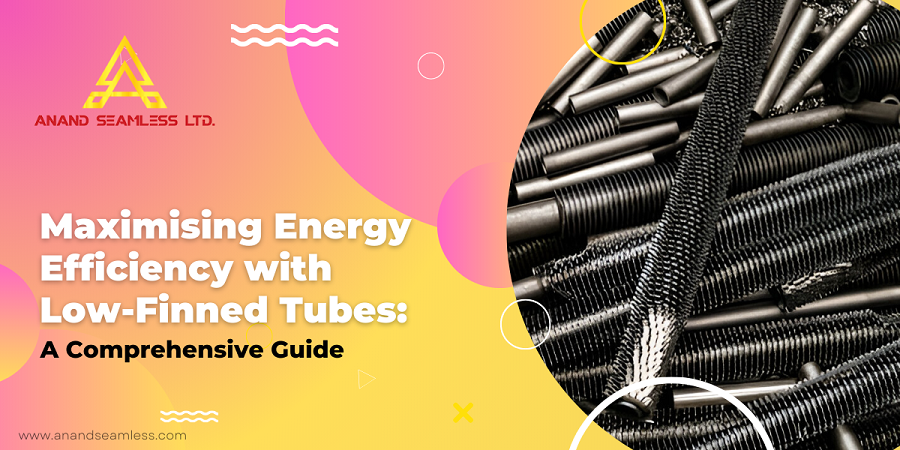Quick Inquiry
Energy efficiency is a key priority in industries where heat exchange plays a vital role. Whether in power plants, HVAC systems, or petrochemical industries, improving heat transfer efficiency can significantly reduce operational costs and environmental impact. One of the most effective solutions to enhance heat exchanger performance is the use of low finned tubes. These specialised tubes provide increased surface area, allowing for better heat dissipation while maintaining a compact design.
In this guide, we explore the science, applications, benefits, and innovations in low finned tubes, helping industries make informed decisions for their energy-efficient systems.

What are Low-Finned Tubes?
Low finned tubes are a type of heat exchanger tube designed with integral fins on the outer surface. These fins increase the effective heat transfer surface without significantly increasing the tube’s volume, making them highly efficient for various industrial applications. Unlike high-finned tubes, low fin tubes provide an optimal balance between enhanced heat transfer and reduced pressure drop, making them ideal for applications requiring moderate heat exchange improvements.
The Science Behind Low-Finned Tubes
How Fin Density Impacts Heat Transfer
The number of fins per unit length, known as fin density, plays a crucial role in heat transfer. Higher fin density increases the surface area available for heat dissipation, improving overall efficiency. However, excessive fin density may lead to increased air resistance, reducing the effectiveness of natural convection cooling.
Surface Area Enhancement for Improved Efficiency
One of the primary advantages of low finned tubes is their ability to maximise heat transfer without requiring additional space. By adding fins, the total surface area increases, facilitating better thermal exchange between the fluid inside the tube and the external environment.
Thermal Conductivity and Resistance Factors
The thermal conductivity of the base tube material and fins plays a significant role in overall efficiency. Materials like copper, aluminum, and stainless steel are commonly used due to their high thermal conductivity. Additionally, the resistance to thermal expansion and corrosion affects the longevity and effectiveness of the low fin tubes in different environments.
Applications of Low-Finned Tubes
Power Plants and Energy Generation
In power plants, low finned tubes enhance the efficiency of boilers, condensers, and heat exchangers by improving heat transfer rates. This leads to reduced fuel consumption and lower operational costs.
HVAC and Refrigeration Systems
Heating, ventilation, and air conditioning (HVAC) systems rely on low fin tubes for better heat dissipation in evaporators and condensers, contributing to energy-efficient cooling and heating solutions.
Oil & Gas and Petrochemical Industries
Integral low fin tubes are widely used in refineries and chemical processing plants to optimise heat recovery systems, ensuring efficient temperature regulation while withstanding harsh operating conditions.
Marine and Desalination Plants
In marine applications, low finned tubes are used in seawater-cooled heat exchangers. Their corrosion-resistant properties make them suitable for desalination plants where efficient thermal exchange is essential for converting seawater into freshwater.
Benefits of Using Low Finned Tubes for Energy Efficiency
1. Increased Heat Transfer Efficiency
By increasing the surface area, low fin tubes enhance heat dissipation, allowing industries to achieve higher thermal efficiency in their heat exchange processes.
2. Reduced Energy Consumption and Operational Costs
With improved heat transfer capabilities, low finned tubes reduce the need for excessive energy input, lowering electricity and fuel costs for industrial operations.
3. Compact Design for Space-Saving Installations
Unlike traditional heat exchanger tubes, integral low fin tubes provide a space-saving solution, making them ideal for compact equipment designs without compromising efficiency.
4. Enhanced Durability and Longevity
High-quality low finned tubes are designed to withstand extreme temperatures, pressures, and corrosive environments, ensuring long-lasting performance with minimal maintenance.
How to Select the Right Low Finned Tubes for Your Needs
1. Choose the Right Material: Copper, Aluminum, Stainless Steel, etc.
The choice of material depends on the specific application. Copper offers excellent thermal conductivity, while stainless steel provides durability and corrosion resistance. Aluminum, on the other hand, is lightweight and cost-effective.
2. Fin Design Considerations for Specific Industries
Different industries require unique fin geometries for optimal performance. The selection of fin height, density, and thickness should align with the application’s thermal and mechanical requirements.
3. Customisation Options for Optimised Performance
Manufacturers offer customisable low-finned tubes, allowing businesses to tailor tube specifications to meet their exact heat exchanger needs, maximising efficiency and cost-effectiveness.
Innovations in Low Finned Tube Technology
1. Advances in Manufacturing Techniques
State-of-the-art manufacturing processes have led to the development of integral low fin tubes with superior precision, ensuring enhanced heat transfer efficiency and durability.
2. Coatings and Corrosion Resistance Improvements
To extend service life, modern low finned tubes are often coated with anti-corrosion materials. These coatings prevent oxidation, fouling, and other forms of degradation, making them ideal for harsh environments.
3. Integration with Modern Heat Exchanger Designs
Advancements in heat exchanger technology have led to the seamless integration of low finned tubes into modern industrial systems, enabling more compact and efficient thermal management solutions.
Installation and Maintenance Best Practices
1. Proper Handling and Installation Techniques
To ensure optimal performance, low fin tubes must be handled carefully during installation. Proper alignment and secure fastening help maintain the integrity of the fins and maximise heat transfer efficiency.
2. Cleaning and Maintenance Guidelines for Optimal Performance
Regular cleaning prevents fouling and scaling, which can hinder heat transfer. Using non-corrosive cleaning agents and periodic inspections can help maintain efficiency and prolong the life of low finned tubes.
3. Common Issues and Troubleshooting Tips
Industries may encounter challenges such as fin clogging, corrosion, or mechanical damage. Routine inspections, timely replacements, and preventive maintenance can mitigate these issues, ensuring uninterrupted operation.
Optimise Your Energy Efficiency with Low-Finned Tubes Today!
Maximise heat transfer, reduce energy costs and enhance system performance with low finned tubes. Whether you operate in power generation, HVAC, petrochemicals, or marine industries, these advanced heat exchanger tubes provide the perfect balance of efficiency and durability. Designed to increase surface area without compromising space, low fin tubes ensure optimal thermal performance for your operations.
Looking for customised solutions? Choose from a range of high-quality materials, coatings, and designs tailored to meet your industry’s specific needs. Partner with Anand Seamless Limited, one of the most trusted finned tube manufacturers and exporters in India and take your energy efficiency to the next level.
We export our products to different countries across the world including Vietnam, Germany, Indonesia, Kuwait, Oman, Qatar, Spain, Thailand, Egypt, United Kingdom. Contact us at +91-9099996853 to discuss your requirements and get a tailored solution for your business!
lATEST BLOG |
|
U-Tube vs. Straight-Tube Heat Exchangers: Comparison Guide
Heat exchangers play a crucial role in industries |
|
Destructive vs. Non-Destructive Testing for Seamless Tubes
Seamless tubes play a critical role in industries |
|
The Hidden Costs of Poor-Quality Heat Exchanger Tubes: A Manufacturer’s Perspective
Heat exchangers play a critical role in various in |
|
Seamless Tubes in Boiler and Power Plants: Why They Are a Game-Changer
Seamless tubes are crucial in various industrial a |
|
Comparing Circular vs. Rectangular Finned Tubes: Which One Works Best?
In heat transfer applications, finned tube heat ex |

